History
Ion Perdicaris purchased the property, hitherto known as Aidonia [2] or Idonia, [3] in the 1870s and erected an eclectic villa in its midst, also known as "Château Perdicaris". [1]
In 1930, the Perdicaris family sold it to Marrakesh-based strongman Thami El Glaoui, who used it as his residence when visiting Tangier. [3] [4]
After the death of El Glaoui followed by the independence of Morocco in 1956, the park became a state property. [5] Following a period of neglect, renovation started in 2015. [6] The villa was repurposed as a heritage center, inaugurated in early 2022. [7]
The park is home to hundreds of different botanical species. [8]

There are around 56,986 km (35,409 mi) of roads in Morocco. In addition to 1,808 km (1,123 mi) of highways.

Tangier or Tangiers is a city in northwestern Morocco, on the coasts of the Mediterranean Sea and the Atlantic Ocean. The city is the capital of the Tanger-Tetouan-Al Hoceima region, as well as the Tangier-Assilah Prefecture of Morocco.

The Rif or Riff, also called Rif Mountains, is a geographic region in northern Morocco. It is bordered on the north by the Mediterranean Sea and Spain and on the west by the Atlantic Ocean, and is the homeland of the Rifians and the Jebala people. This mountainous and fertile area is bordered by Cape Spartel and Tangier to the west, by Berkane and the Moulouya River to the east, by the Mediterranean to the north, and by the Ouergha River to the south. The Rif mountains are separated into the eastern Rif mountains and western Rif mountains.
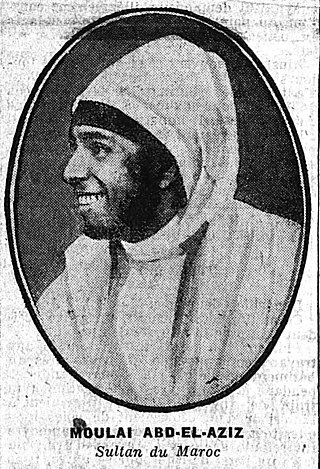
MoulayAbd al-Aziz bin Hassan, born on 24 February 1881 in Marrakesh and died on 10 June 1943 in Tangier, was a sultan of Morocco from 9 June 1894 to 21 August 1908, as a ruler of the 'Alawi dynasty. He was proclaimed sultan at the age of sixteen after the death of his father Hassan I. Moulay Abdelaziz tried to strengthen the central government by implementing a new tax on agriculture and livestock, a measure which was strongly opposed by sections of the society. This in turn led Abdelaziz to mortgage the customs revenues and to borrow heavily from the French, which was met with widespread revolt and a revolution that deposed him in 1908 in favor of his brother Abd al-Hafid.

Mohammed Ben Aarafa, or Ben Arafa, was a paternal first cousin once removed of Sultan Mohammed V of Morocco; he was put in Mohammed V's place by the French after they exiled Mohammed V to Madagascar in August 1953. His reign as "Mohammed VI" was not recognized in the Spanish-protected part of Morocco. Protests against Ben Aarafa helped lead to Moroccan independence, which was agreed to between France and Mohammed V, after his abdication in October 1955.

The Perdicaris affair, also known as the Perdicaris incident, refers to the kidnapping of Greek-American Ion Hanford Perdicaris (1840–1925) and his stepson, Cromwell Varley, a British subject, by Ahmed al-Raisuni and his bandits on 18 May 1904 in Tangier, Morocco. Raisuni, leader of several hill tribes, demanded a ransom of $70,000, safe conduct, and control of two of Morocco's wealthiest districts from the Sultan of Morocco Abd al-Aziz. During lengthy negotiations, he increased his demands to control of six districts. The historical importance of the affair lay not in the kidnapping itself but in the concentration of naval power in Tangier and what it meant for the politics of gunboat diplomacy.
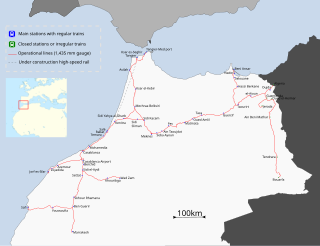
ONCF is Morocco's national railway operator. ONCF is a state-owned company that is under the control of the Ministry of Equipment, Transport and Logistics and is responsible for all passenger and freight traffic on the national railway network. The company is also responsible for building and maintaining the rail infrastructure.

Tangier Ibn Battouta Airport Arabic: مطار طنجة ابن بطوطة) is an international airport serving Tangier, the capital city of the Tanger-Tetouan-Al Hoceima region in Morocco. The airport is named after Ibn Battuta (1304–1368), a Moroccan traveller who was born in Tangier. The airport was formerly known as Tanger-Boukhalef Airport. The airport handled over 1,070,247 passengers in the year 2017.
Princess Lalla Abla bint Tahar was the princess consort of Morocco from 1955 to 1961, the mother of King Hassan II and the grandmother of King Mohammed VI

Nador International Airport, , is an international airport serving Nador, a city in the Oriental region in Morocco. It is also known as Arwi Airport.

Rail transport in Morocco is operated by the national railway operator ONCF. It was initially developed during the protectorate.

The Tangier International Zone was a 382 km2 (147 sq mi) international zone centered on the city of Tangier, Morocco, which existed from 1925 until its reintegration into independent Morocco in 1956, with interruption during the Spanish occupation of Tangier (1940–1945), and special economic status extended until early 1960. Surrounded on the land side by the Spanish protectorate in Morocco, it was governed under a unique and complex system that involved various European nations, the United States, and the Sultan of Morocco, himself under a French protectorate. Due to its status as international zone, Tangier played a crucial role for Moroccan Nationalists, who wanted independence, to establish (international) contacts and recruite allies as well as organising gatherings and events.
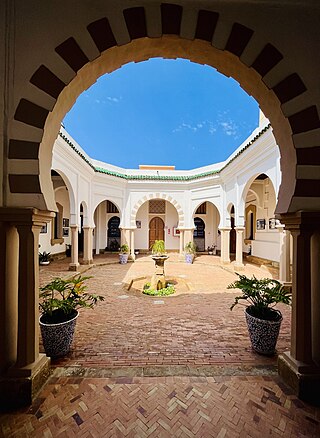
Cape Spartel is a promontory in Morocco about 1,000 feet (300 m) above sea level at the entrance to the Strait of Gibraltar, 12 km west of Tangier. It is the northwesternmost point of the African continent. Below the cape are the Caves of Hercules.
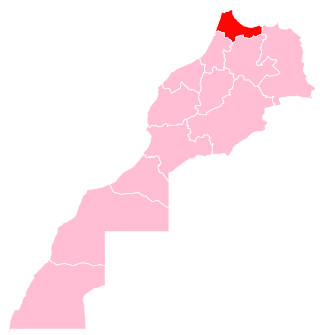
Tangier-Tetouan-Al Hoceima is the northernmost of the twelve regions of Morocco. It covers an area of 15,090 km2 and recorded a population of 3,556,729 in the 2014 Moroccan census. The capital of the region is Tangier.
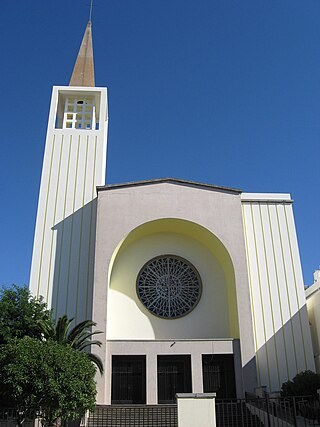
The Roman Catholic Cathedral of Tangier, whose full name is the Cathedral of the Immaculate Conception and the Holy Spirit, also known as the Spanish Cathedral, is the seat of the Roman Catholic Archdiocese of Tangier, Morocco.
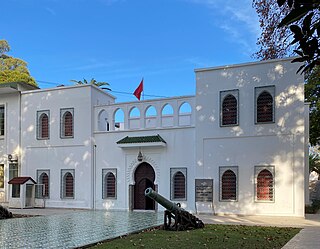
The Mendoubia or Mandubiyya refers to the former ceremonial mansion of the Mendoub, the representative of the Sultan of Morocco in the Tangier International Zone from 1924 to 1956. It now houses the commercial court of Tangier and a memorial museum.

The Mendoub or Mandub was a key official in the governance of the Tangier International Zone between 1925 and 1956, with a wartime interruption from 1940 to 1945.

Ion Hanford Perdicaris was an author, professor, lawyer, painter, and playwright. He was a humanitarian and human rights activist. He fought for the rights of Moors, Arabs, and slaves. He was active in the anti-slave movement in the United States and abroad namely in Morocco. Ion fought to change the Protégé system in Morocco. Ion became an international celebrity because of the Perdicaris Incident.

Si El Madani El Glaoui, born Madani El Mezouari El Glaoui, nicknamed the faqih was a prominent statesman in Morocco during the late 19th century and early 20th century. He was largely responsible for establishing the Glaoui family's power in the country.


















